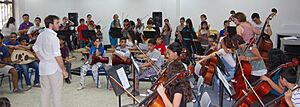Edward Said National Conservatory of Music facts for kids
The Edward Said National Conservatory of Music (which means Ma`had Edward Sa`īd al-Waṭaniy lil-Musīqā in Arabic) is a special music school in Palestine. It has different locations in cities like Ramallah, Jerusalem, Bethlehem, Nablus, and Gaza City. More than 1,000 students learn music here!
The school started in 1993. Back then, it was just called The National Conservatory of Music. Its first branch opened in Ramallah in October of that year. In September 2004, the school changed its name to honor Edward Said. He was a famous Palestinian writer and music lover. He was also a great classical pianist and helped start groups that bring musicians from different cultures together, like the West-Eastern Divan Orchestra.
Contents
Music Groups and Orchestras
The Edward Said National Conservatory of Music (ESNCM) helps run several music groups. These include the Palestine Youth Orchestra and the Palestine National Orchestra. There are also many smaller groups.
For example, the Palestine Strings ensemble is a newer group. They played with famous violinist Nigel Kennedy in 2012. They also toured the United States in 2011.
The Palestine Youth Orchestra (PYO) has performed in many places. They've played in Palestine, Italy, Jordan, Greece, Bahrain, Germany, Syria, and Lebanon. Big international groups, like the Oslo Philharmonic Orchestra, support them.
The ESNCM's professional orchestra, the Palestine National Orchestra (PNO), started in December 2010. They have performed in Palestine, Jordan, and Indonesia. Both the PYO and PNO like to play music by Arab composers who are alive today.
The ESNCM Orchestra is the only symphony orchestra in Palestine where all the musicians live in the local communities. They perform concerts all year in Palestinian towns and cities. They play a mix of music, including classical, opera, Arabic music, and film music.
The ESNCM also has several Arabic music groups. Some are for students, and some are for professionals. These groups have traveled and performed around the world. ESNCM students have also worked with well-known international musicians.
Music Festivals and Shows
The ESNCM organizes two big music festivals. They also put on concerts throughout Palestine all year long. These concerts feature Arabic, classical, and jazz music.
The conservatory is in charge of the yearly Arabic music festival called Layali Tarab fi Quds al Arab. They also organize the Jasmine Festival, which mostly features classical music.
How It Started
In 1990, five Palestinian musicians and teachers looked into how music education was doing in Palestine. They found that there was a big need for a music school.
So, in 1993, after three years of hard work, the conservatory opened. Many friends helped and encouraged them, like Edward Karkar, Munther Nabulsi, Huda Khoury, and Linda Khalil Khoury. It was first called the National Conservatory of Music.
It became part of Birzeit University. The university gave the conservatory space in its building in Ramallah. They also appointed the founders to oversee the school. These founders were Salwa Tabri, Rima Tarazi, Amin Nasser, Nadia Abboushi, and Suhail Khoury.
In October 1993, the first branch opened in Ramallah. It had 40 students, three part-time teachers, a secretary, and a volunteer director, Amin Nasser. A few years later, new branches opened in Jerusalem and Bethlehem. The Nablus branch started in the summer of 2010.
In September 2004, the school changed its name to The Edward Said National Conservatory of Music. This was to honor Edward Said, who was an honorary member of the school's board.
Where You Can Find It
The ESNCM has five branches. They are in Jerusalem, Ramallah, Bethlehem, Nablus, and Gaza City. The Gaza City branch opened in 2012. Together, these branches teach over 1,000 students.
Each branch has its own director and manager. They handle the daily activities of their school. This setup makes it easy to open new branches in the future. It also makes sure that students get the same great education and services, no matter which city their ESNCM branch is in.
What You Can Study
The ESNCM offers two main ways to study music: the regular program and the amateur program.
The Regular Music Program
This program is for students who want a full and structured music education. It teaches them about instruments and music theory. It has three levels:
- The Preparatory level. This level is not required for everyone.
- The Elementary level.
- The Intermediate level.
After finishing all three levels successfully, students can get a diploma. This diploma will help them if they want to go to the university-level program at the ESNCM (which is not open yet). This higher program will train them to become professional musicians.
The Regular Program includes learning a Western or Arabic instrument. Students take exams for 8 grades, and each grade can be finished in about 20 months. This program also teaches music theory, ear training, and the history of Arabic, classical, jazz, and world music. It also focuses on playing music in groups, singing in choirs, and playing Arabic percussion instruments together.
The Fun Amateur Program
This program offers private lessons for people who love music but don't want to follow a strict curriculum or take exams. Sometimes, amateur students can join other group classes if the teacher agrees. This is only if the student is at a level where they can learn from the class. Students in the amateur program do not get special credits or certificates for the classes they take.
See also
 In Spanish: Conservatorio Nacional de Música Edward Said para niños
In Spanish: Conservatorio Nacional de Música Edward Said para niños


